Disclaimer: As an Amazon Associate I earn from qualifying purchases. Therefore, we may collect a share of sales from the links on this page, at no extra cost to you!
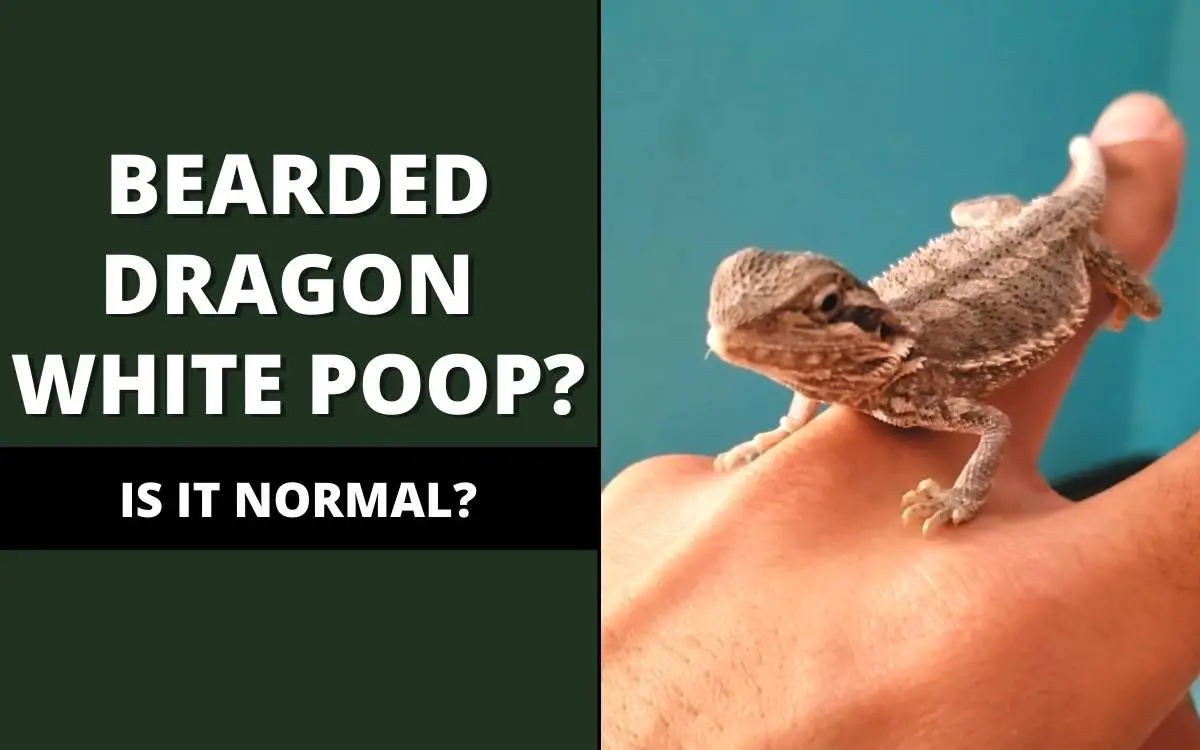
Keeping bearded dragons comes with great responsibility. You have to ensure they are well-fed, clean, and healthy. Part of being a bearded dragon keeper is knowing the difference between unhealthy and healthy poop.
We understand that poop is not the best thing to look at or smell. However, you should take time to study your bearded dragon’s poop. The best time to do this is when you are cleaning the enclosure.
Moreover, bearded dragon poop can tell you a lot about the health of your beardie. As such, you can detect certain underlying health conditions before the problem worsens. A bearded dragon’s poop can vary in color, consistency, and texture.
That being said, let us jump right into the discussion—My bearded dragon has white poop: is it normal or should I be concerned?
Healthy bearded dragon poop has white and brown parts. The white section is made of urate, while the latter is fecal matter. However, if the poop is all white, it means your bearded dragon is overhydrated. The lack of brown fecal matter also indicates they have not eaten in a while.
Keep reading to learn more life-saving facts about bearded dragon poop and when you should be concerned for the health of your beardie.
Jump to..
Healthy Bearded Dragon Poop
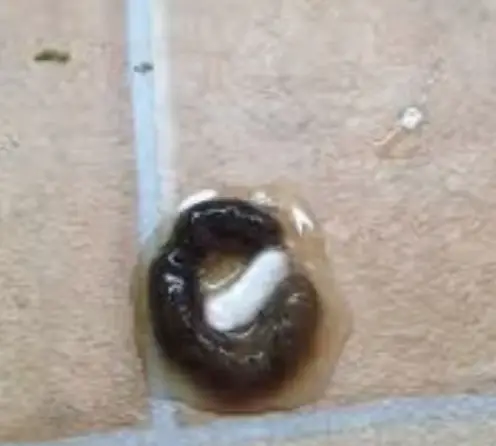
It is good to know what healthy bearded dragon poop looks like since this will make your work easier when making comparisons. As described above, normal beardie poop consists of two colors. The brown part makes up the largest portion and is often log-shaped.
As for the white portion, it often sits atop the brown part. Nonetheless, it can also be on the sides. When it comes to consistency, the urate should be soft while the fecal matter is known to be firm. Also, the urate should not have a pungent smell.
It is important to note that bearded dragon poop may have a darker or lighter coloration. For instance, the urate may at times appear yellowish. We are going to cover the common poop colors later in the articles, so continue reading.
What Are Urates In Bearded Dragon Poop?
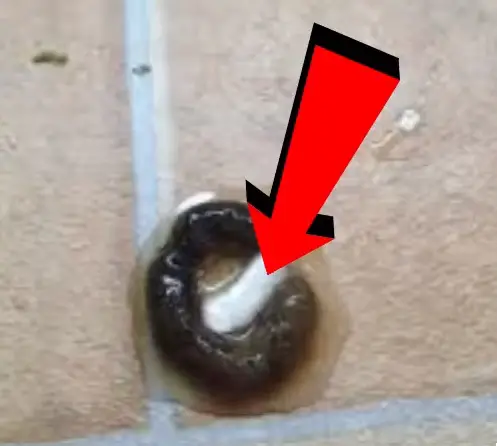
In a nutshell, urates are a by-product of metabolism. And since bearded dragons cannot pee, they eliminate the waste in the form of uric acid, also known as urates. Beardies can extract uric acid from their blood through the kidneys.
The color and texture of urate on a beardie’s poop can tell you whether they are well hydrated or dehydrated. This is one of the reasons why you should monitor your bearded dragon’s poop regularly.
Bearded Dragon Poop Color
The color of bearded dragon poop may change due to a variety of factors. Below are some of the common colors that you should expect to see when your beardie poops:
Yellow Bearded Dragon Poop
It is common for bearded dragons to excrete yellow urate. This is can be an indication of dehydration, so you should consider providing your beardie with water. The yellow coloration can also come from red or yellow-colored fruits/vegetables in the beardie’s diet.
Squash and carrots are some of the common vegetables that can change the color of the bearded dragon’s poop. Nonetheless, this can only happen if they feed on such foods regularly.
Poop can also be yellow when there is too much calcium in the bearded dragon’s body.
Green Bearded Dragon Poop
Green excreta in bearded dragons is often caused by high-chlorophyll vegetables. The green coloration can also come about when you feed your bearded dragon colored pellets.
Certain types of medications may also turn bearded dragon poop green. If the poop is green but firm, there is nothing to worry about.
Black Bearded Dragon Poop
If your bearded dragon’s poop is black, it means you have been feeding them too many bugs. To keep your pet beardie healthy, their diet should constitute 75% vegetable and 25% insect.
In fact, the green color of vegetables combines with the black shade in most insects to give the fecal matter its brown color. Ensure that you balance out your beardie’s diet to avoid health complications.
Also, insects with hard exoskeletons should be fed in minimal amounts. This is because they require a lot of time to digest and may also exert pressure on the digestive system.
Red Bearded Dragon Poop
Beardies can excrete red poop if you recently fed them red-colored fruits and vegetables. As you can see, whatever you feed your bearded dragon can change the color of their poop.
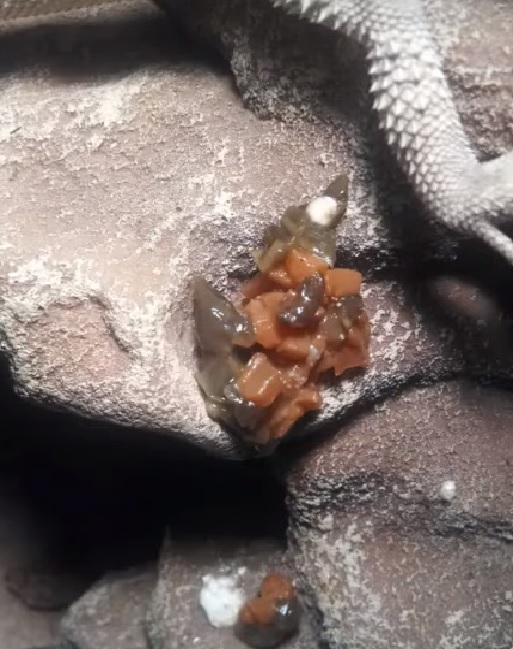
Blood in Bearded Dragon Poop
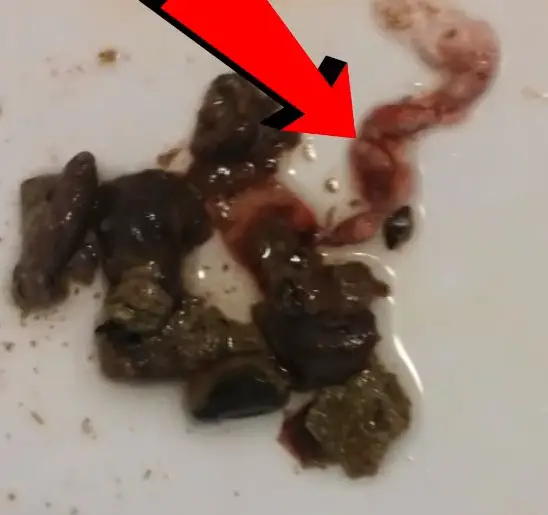
It can be shocking to see blood in your bearded dragon’s poop, but it happens. Bloody poop often indicates the presence of gastrointestinal problems. Red poop can easily be mistaken for bloody poop and vice versa.
As such, you should stop feeding your beardie red-colored foods to ascertain the true cause of the problem. If the poop still appears red, it could mean there is a problem with your bearded dragon. A visit to the veterinarian can help you pinpoint the causal factor.
Bloody excreta is common in impacted bearded dragons. The object blocking the gastrointestinal tract can tear the gut lining. This will, in turn, cause internal bleeding and may predispose the beardie to infections.
High-chitin insects such as locusts can also cause injuries to the intestines. This can happen if the insect in question is fed to the bearded dragon with the sharp legs attached. Intestinal parasites such as hookworms, roundworms, Coccidia, and pinworms can also cause bleeding in the guts.
Signs That Your Bearded Dragon Has Gastrointestinal Parasites
Intestinal parasites can cause serious health complications in bearded dragons. In worst-case scenarios, the beardie can die. Treatment for parasite infestations can only be successful if the problem is detected early.
Here are some of the common signs that can help you determine if your beardie has endoparasites:
Vomiting
Bearded dragons with parasite infestations often regurgitate their food immediately or a few hours after eating. Prolonged vomiting can cause dehydration and other health problems.
Weight Loss
Most endoparasites survive by eating the host’s food. As such, your bearded dragon won’t get the full nutritional benefits of the food that you feed them. This will cause the body to starve over time, resulting in weight loss.
Loss of Appetite
Virtually all intestinal parasite infestations result in reduced appetite at some point. As a result, the affected bearded dragon will eat small amounts of food or may refuse to eat.
Presence of Parasites in Poop
Some gastrointestinal parasites are visible to the naked eye. If you see any, you should schedule an appointment with your vet before it’s too late. The presence of mucus in the poop is also another indicator.
Lethargy
Most of the above-listed symptoms can lead to a lack of energy. Your bearded dragon may become lethargic until proper treatment is administered.
Bearded Dragon Runny Poop
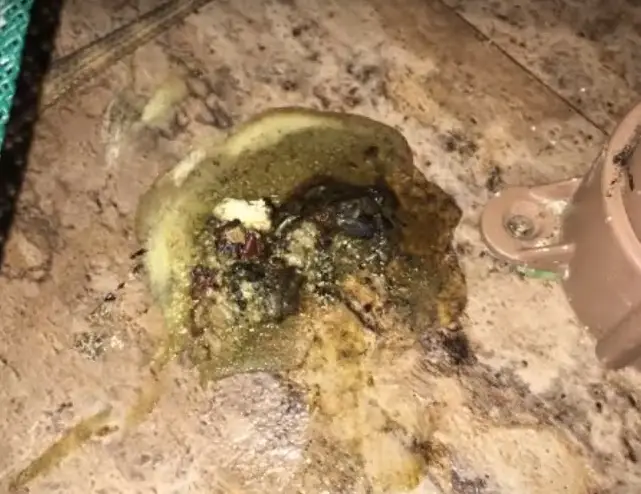
Diarrhea is the primary cause of runny poop in bearded dragons. Beardies can suffer from diarrhea when there is a change in their diet. Gastrointestinal parasites can also bring about this condition.
Runny poop can be attributed to parasitic infections if the fecal matter is overly smelly, bloody, or has mucus. In terms of diet, certain high fiber vegetables and fruits may cause your beardie to excrete runny poop. This particularly applies to foods that are hard to digest.
How Often Do Bearded Dragons Poop?
Several factors can determine how often your bearded dragon poops. However, predicting the beardie’s next bowel movement is not easy.
Diet
The type of food that a bearded dragon eats can either increase or decrease the frequency of pooping. Feeding beardies high calcium foods such as silkworms can cause them to poop more often.
Bearded dragons that solely rely on vegetables and crickets may poop less often compared to the former. Ensure that you consult your vet before incorporating new foods or supplements into your pet’s diet.
Age
If you are an expert beardie keeper, then you must be aware that baby bearded dragons eat a lot. They consume more food than juveniles and adult beardies.
To give you a quick summary of a bearded dragon’s feeding requirements based on age—baby beardies should be fed daily, juveniles every other day, while adults need food only 2-3 times per week. Beardies that eat more often poop a lot.
Heat
Like all cold-blooded animals, bearded dragons require heat to digest their food. Suboptimal temperature conditions can slow down the digestion process. The result is that your bearded dragon will poop less often.
Inversely, optimal temperature levels will allow for quick digestion, leading to increased bowel movements.
Why Is My Bearded Dragon Not Pooping?
According to beardie experts, adult bearded dragons should poop at least thrice per week. This may, however, vary depending on factors that we have just discussed. Most beardies stop pooping due to the below factors:
#1. Impaction
Impaction is the leading cause of death in young bearded dragons. It can also affect adult bearded dragons, making it a serious problem. Impaction is characterized by the hardening of fecal matter in the gastrointestinal tract.
This condition can be caused by indigestible materials in the bearded dragon’s gut. Loose substrates are known to cause impaction in bearded dragons, so you should avoid them. Ceramic tiles, reptile carpets, and paper towels can be a great alternative.
If you suspect your beardie is impacted, you should rush them to the vet. Mild cases of impaction can be remediated at home by soaking the beardie in lukewarm water for 15-20 minutes.
Common Signs of Impaction in Bearded Dragons:
- Loss of appetite
- Lethargy
- Regurgitation
- Dragging of hind limbs
- Inability to excrete
#2. Brumation
Brumation is a natural process in which bearded dragons go into a state of inactivity. During this period, beardies essentially slow their breathing rate, metabolism, and heart rate.
Bearded dragons in brumation can go for days without eating. This means they will be less likely to poop compared to when they are not in brumation. Food should be provided in minimal amounts to avoid wastage.
In addition to this, you should do away with the leftovers when cleaning the enclosure. Water is essential for brumating bearded dragons, so ensure that your beardie is getting enough fluids.
Signs of Brumation in Bearded Dragons:
- Reduced bowel movements
- Less eating
- Frequent sleep
- Burrowing
How to Make a Bearded Dragon Poop?
There are many things that you can do to help your bearded dragon poop:
Rehydration
Water plays a critical role during the digestion process. Dehydrated bearded dragons may take a longer time digesting food. Suspected cases of dehydration should be countered by providing the beardie with water.
You can tell if your bearded dragon is dehydrated by observing their poop. Beardies suffering from dehydration eliminate dry chalky poop.
Provide Appropriate Temperature
Bearded dragons can only poop when food is broken down in their digestive system. And for digestion to occur, the temperature conditions must be favorable.
Pet beardies require a basking spot with a temperature setting of 88°F to 100°F.To prevent overheating, the enclosure should have a cooling area of between 77°F and 85°F.
Homemade Laxative
A laxative is any substance that can loosen fecal matter, thereby increasing bowel movements. As such, they can come in handy when dealing with constipated bearded dragons.
There are several homemade laxatives that you can give your bearded dragon. Natural olive oil is highly preferred since it does not contain any harmful compounds.
Beardie experts recommend that you give your bearded dragon 3-4 drops of organic olive oil per day. This should be done repeatedly until the beardie poops. A spoonful of pumpkin puree can also get the job done.
Warm Baths
Giving your bearded dragon warm baths can alleviate impaction. Allow the beardie to soak in the water for a few minutes as stated earlier. The bathwater should have a temperature of about 90°F to 100°F.
Also, the water should not go above the bearded dragon’s shoulders as this can trigger the fear of drowning.
White Bearded Dragon Poop: What's The Verdict?
It’s normal for bearded dragons to excrete white poop. The urate in the poop gives it the color, so you should not be worried if the excreta are white.
However, if your bearded dragon’s poop is chalky white, it means they are dehydrated. You can correct this by providing the beardie with water.
We hope you learned something new in this article. If you’d like to learn more about keeping your bearded dragon in perfect health, be sure to check out our full care guide!
